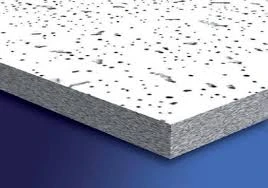Dec . 07, 2024 00:27 Back to list
Grid Ceiling Board Design for Modern Interior Spaces and Aesthetic Appeal
Understanding Grid Ceiling Boards A Comprehensive Overview
Grid ceiling boards, also known as suspended ceilings or dropped ceilings, have become an essential element in modern architectural design. They serve both functional and aesthetic purposes, making them a popular choice for commercial and residential spaces. This article aims to provide a detailed exploration of grid ceiling boards, encompassing their composition, benefits, installation process, and applications.
What are Grid Ceiling Boards?
Grid ceiling boards are part of a ceiling system that consists of a metal framework (the grid) and acoustical tiles (the boards) suspended below the main ceiling structure of a building. The grid is typically made from lightweight metal materials, and the boards can be composed of a variety of materials, including mineral fiber, fiberglass, and metal. This system is designed to create a clean and uniform ceiling surface while allowing for access to the infrastructure above, such as plumbing, electrical wiring, and HVAC systems.
Benefits of Grid Ceiling Boards
1. Aesthetic Appeal One of the primary advantages of grid ceiling boards is their ability to enhance the aesthetic value of a space. These ceilings come in various designs, textures, and colors, enabling builders and architects to customize interiors. They can create a modern, sleek look or a more traditional appearance, depending on the selected tiles.
2. Acoustic Control Grid ceiling boards are effective at sound absorption, making them ideal for environments where noise reduction is essential, such as offices, schools, and restaurants. The materials used in the boards can help to minimize echo and provide a quieter atmosphere.
3. Easy Access to Utilities Because grid ceilings are suspended, they allow easy access to plumbing, wiring, and air ducts. This feature is particularly useful for maintenance and repairs, as panels can be removed without significant disruption to the environment.
4. Energy Efficiency Certain grid ceiling boards are designed to improve energy efficiency. By incorporating insulation properties, they can contribute to reducing heating and cooling costs in buildings. Additionally, they can be combined with lighting solutions to create an energy-efficient lighting ambiance.
5. Fire Resistance and Safety Many grid ceiling boards are created with fire-resistant materials, enhancing safety in commercial spaces. This is crucial for meeting building codes and ensuring the safety of occupants.
Installation Process
grid ceiling board

Installing grid ceiling boards is a relatively straightforward process, which is one of the reasons for their popularity. Here’s a general overview of the steps involved
1. Planning and Measurement Accurate measurements are taken to determine the dimensions of the room and how many grid panels are needed.
2. Framework Installation The metal grid framework is installed first. This involves securing the main runners to the ceiling with appropriate fasteners and then attaching cross tees to create a grid.
3. Board Installation Once the grid framework is installed, the acoustical tiles are cut to fit, if needed, and placed into the grid. There are typically no tools required for this step, making it easy for contractors and DIY enthusiasts alike.
4. Finishing Touches Finally, any necessary finishing touches, such as caulking or edge treatments, can be applied to ensure a clean look.
Applications of Grid Ceiling Boards
Grid ceiling boards are versatile and can be used in various settings, including
- Commercial Spaces Offices, retail stores, and shopping malls often utilize grid ceiling systems for their functional benefits and aesthetics. - Educational Institutions Schools and universities benefit from the sound-absorbing qualities of grid ceilings, creating conducive learning environments. - Healthcare Facilities Hospitals and clinics require ceilings that meet stringent hygiene and safety standards, making grid ceiling boards an excellent choice.
- Residential Spaces Homeowners can use grid ceilings in basements, living rooms, or utility spaces to enhance aesthetics while providing easy access to utilities.
Conclusion
Grid ceiling boards represent a blend of practicality and aesthetic appeal, fulfilling the demands of modern architecture. With benefits ranging from sound reduction to ease of maintenance and improved energy efficiency, they have established themselves as an indispensable part of many buildings. Whether you are considering a renovation or starting a new project, grid ceiling boards are worth considering for both their functionality and design versatility.
-
Durable Ceiling T Grid Systems | Easy InstallationNewsAug.29,2025
-
PVC Gypsum Ceiling: Durable, Laminated Tiles for Modern SpacesNewsAug.28,2025
-
Pvc Gypsum Ceiling Is DurableNewsAug.21,2025
-
Mineral Fiber Board Is DurableNewsAug.21,2025
-
Ceiling Tile Clip Reusable DesignNewsAug.21,2025
-
Ceiling T Grid Modular DesignNewsAug.21,2025







